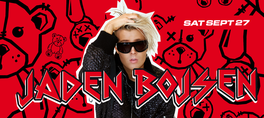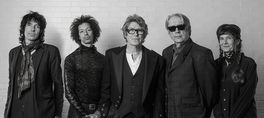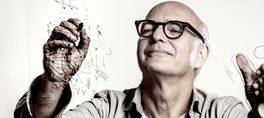Mikal Cronin
On October 25,
Mikal Cronin
will release
Seeker
, his fourth and finest full
-
length to date.
Recorded live with a crew of close friends and engineer Jason Quever at Palmetto Studios in
Los Angeles, it finds Cronin pushing his often devastating power
pop
into darker
territory
—
from the isolation of “Show Me” to the desperation of “Fire” to the unadorned
heartache of “Sold.”
It comes with a backstory that feels like fate
. Cronin writes:
I was stuck. I’d had a rough few years. Relationships end, begin, and
end again. I had to stay
active, tour with other bands, make music through various other avenues
—
writer’s block is
real and it can crush you, scratching at an itch you can’t quite get. I needed to clean up, to
stop leaning on external crutches to get thro
ugh the anxiety. I needed to grow the fuck up.
I needed a change.
I went to the woods, to Idyllwild, a small town in the mountains of southern California. I spent
a month in a cabin there, alone with my cat, Ernie. It was so quiet and peaceful. I got w
eird
looks at the store. I got bug bites that didn’t heal for months. I walked around a small lake a
few times. I wrote.
I took literally something that’s usually a hypothetical, something every
artist thinks about doing. It worked: A large majority of
Seeker
was written and demoed
there.
But then I had to go, immediately. An arsonist had sparked a series of fires and the woods
exploded. I saw the flames coming up the hill as I packed up all my instruments and recording
equipment. Ernie hid under the be
d and was the last to go. I got him in the car just as the
police came up the street to help with evacuations. I ended up home in LA a few days early; a
small blessing because I was losing my mind a bit.
Once I was back, I was ready to make something. I
needed help. I found Jason [Quever] and his
studio. I collected as many friends as I could and brought them in to record live with me. I
needed the energy of a group of people in a room playing together
—
a simple concept but one
that I had never tried with
my own songs. Most of the record is backed by Ty Segall’s Freedom
Band. I play bass in this band. We had been touring and playing together for a long run over a
few years, so it seemed natural to stick together.
I aimed for nature. I wanted organic sounds
. I wanted to bring you into the room. Jason and I
talked about The Beatles’
White Album
a lot when placing mics. I brought a charred pine
cone from the woods to the studio, just in case it would help.
Fire
—
specifically its cycle of
purging and reseeding t
he landscape
—
is a central theme to the record. Death and rebirth.
I was looking for something: an
swers, direction, peace.
I am the seeker.
Mikal Cronin
On October 25,
Mikal Cronin
will release
Seeker
, his fourth and finest full
-
length to date.
Recorded live with a crew of close friends and engineer Jason Quever at Palmetto Studios in
Los Angeles, it finds Cronin pushing his often devastating power
pop
into darker
territory
—
from the isolation of “Show Me” to the desperation of “Fire” to the unadorned
heartache of “Sold.”
It comes with a backstory that feels like fate
. Cronin writes:
I was stuck. I’d had a rough few years. Relationships end, begin, and
end again. I had to stay
active, tour with other bands, make music through various other avenues
—
writer’s block is
real and it can crush you, scratching at an itch you can’t quite get. I needed to clean up, to
stop leaning on external crutches to get thro
ugh the anxiety. I needed to grow the fuck up.
I needed a change.
I went to the woods, to Idyllwild, a small town in the mountains of southern California. I spent
a month in a cabin there, alone with my cat, Ernie. It was so quiet and peaceful. I got w
eird
looks at the store. I got bug bites that didn’t heal for months. I walked around a small lake a
few times. I wrote.
I took literally something that’s usually a hypothetical, something every
artist thinks about doing. It worked: A large majority of
Seeker
was written and demoed
there.
But then I had to go, immediately. An arsonist had sparked a series of fires and the woods
exploded. I saw the flames coming up the hill as I packed up all my instruments and recording
equipment. Ernie hid under the be
d and was the last to go. I got him in the car just as the
police came up the street to help with evacuations. I ended up home in LA a few days early; a
small blessing because I was losing my mind a bit.
Once I was back, I was ready to make something. I
needed help. I found Jason [Quever] and his
studio. I collected as many friends as I could and brought them in to record live with me. I
needed the energy of a group of people in a room playing together
—
a simple concept but one
that I had never tried with
my own songs. Most of the record is backed by Ty Segall’s Freedom
Band. I play bass in this band. We had been touring and playing together for a long run over a
few years, so it seemed natural to stick together.
I aimed for nature. I wanted organic sounds
. I wanted to bring you into the room. Jason and I
talked about The Beatles’
White Album
a lot when placing mics. I brought a charred pine
cone from the woods to the studio, just in case it would help.
Fire
—
specifically its cycle of
purging and reseeding t
he landscape
—
is a central theme to the record. Death and rebirth.
I was looking for something: an
swers, direction, peace.
I am the seeker.
show less









